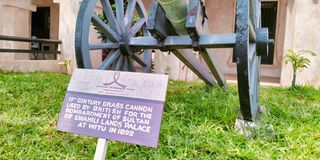
A section of Witu Town. Although the town has existed for over 200 years, it has seen minimal growth and expansion due to a clumsy grid-based urban planning system imposed by the German colonialists who once ruled Wituland.
In the far south of Lamu lies a sleepy market town dominated by mud-walled structures, many with makuti-thatched roofs and a few with corrugated iron.
This is Witu, one of the oldest Swahili settlements in Lamu, dating back over 200 years.
The town, with a population of around 3,000 according to local authorities, acts as a gateway to Lamu from the rest of the country via the Lamu-Witu-Garsen Highway.
It is one of the few Swahili towns to have enjoyed continuous human occupation over the years, unlike other Swahili settlements in the region that have been abandoned and almost forgotten, such as Ungwana, Mwana and Shaka.
Despite this, Witu has not grown at all but has rather stagnated in terms of overall development and subsequent expansion.
While residents cite the marginalisation of Witu Old Town in Lamu County by successive government regimes as a key factor in the town's failure to expand 200 years later, historians take a different view.
Witu is predominantly inhabited by pastoralist communities, including the Orma, Somali, Boni, Sanye and Waata, also known as Watha.
There are also Bajuni people, most of whom migrated from Pate Island in Lamu East.
Residents interviewed by Nation.Africa acknowledged that pastoralists have often been viewed as nomadic people, a situation that usually exposes them to historical injustices such as political marginalisation and racial discrimination.
Fuad Badi, an elder, has lived in Witu for 50 years.
"The town has not seen any significant growth or expansion compared to the other towns. The fact that the people of Witu are pastoralists, many of whom are excluded from development, leads to the conclusion that marginalisation plays a major role," said Mr Badi.
Amina Gobu, a resident, expresses disappointment that many government projects earmarked for Witu are often diverted and end up outside the old town.
Ms Gobu cited the completed Sh10.8 billion Lamu-Witu-Garsen road, which was originally meant to run through Witu town, but was diverted and built as a bypass outside the town.
"If the road had gone through Witu town, it would have brought a lot of development. Some people whose houses were demolished to pave the way for the road would have been compensated, and the money would have improved their lives. New buildings would have sprung up.
Now we're left with our old and corrugated iron structures that give the town a sleepy and neglected look. Even the road that passes through Witu is not in good condition," said Ms Gobu.
On March 9, 2017, former President Uhuru Kenyatta commissioned the construction of the mega road project in Witu town.
Special attention
Residents are pleading with both the county and national governments to give Witu special attention in terms of development projects as it has been left behind for many years at the expense of other towns that continue to grow due to the many projects being undertaken there.
"You can't compare Witu with towns like Mokowe, which was established much later. Unfortunately, Mokowe has grown with both government and private developments taking place there on an almost daily basis. Mokowe is now Lamu's headquarters. It's my prayer that they stop sidelining Witu. Let them give the old town the special attention it deserves in terms of development so that it too can grow," said Ali Bonea, an elder.
However, historians interviewed by the Nation linked the failure of Witu's old town to grow and expand to the colonialists.
Witu was once a German and later a British protectorate.
National Museums of Kenya (NMK) curator in charge of Lamu Museums and World Heritage, Mohammed Ali Mwenje, describes Witu as a Swahili settlement dating back to the 17th and 18th centuries.

The National Museums of Kenya (NMK) curator in charge of Lamu Museums and World Heritage Site, Mohammed Ali Mwenje.
Witu's founding father is believed to have been one of the disgruntled members of the Pate Island monarchy.
Arab descent
At the time, the ruling dynasty in Pate was the Nabahani, who claimed to be of Arab descent.
In the 1810s, however, Seyyid Said, the Imam of Oman, settled in the archipelago and rivalled the Nabahani dynasty.
Pate Island, with the towns of Pate and Siyu, then became an important centre of resistance to Omani supremacy and, from 1840 to the Sultanate of Zanzibar.

A 19th century brass cannon in front of the Lamu Museums in Lamu old town. The cannon is believed to have been used by the British colonialists to bombard the Sultan of Swahililands palace at Witu in 1892.
"To avoid disputes, the Nabahani decided to separate, leaving Pate and going to Witu, where they established a new kingdom or settlement for themselves. That's why the Nabahani dynasty and even some of the people of Witu still have their links and connections with the Pate," says Mwenje.
Witu was also discovered by Germans trying to establish missionaries at the mouth of the Tana Delta. Eventually, more German interest developed.
The two Denhardt brothers - Clemens and Gustav - who had settled in Lamu, set up Wituland.
"Witu was one of the first German areas to be designated as German Wituland under the German East Africa Company. So it became an area of interest to the Germans because it was at the centre of a very lucrative trade in collecting game trophies and other natural products from the neighbouring forest - especially Mambo Sasa," said Mr Mwenje.
International map
German cooperation put Wituland on the international map, with postage stamps issued in 1889.
In 1890, Wituland became part of British East Africa under the terms of the 1890 Helgoland-Zanzibar Treaty, and the Germans eventually moved to Tanganyika.
Mr Mwenje attributes the failure of development to the German system of planning and urbanisation.
He notes that when the Germans settled in Witu, they introduced a form of town planning to generally control the growth of the town.
This evidence is linked to a similar system introduced by the German colonialists in the town of Tanga in Tanzania.
"In Witu town, they introduced a grid-based system where you can still see how houses are built in straight lines. This discouraged developers from building in any way. There was also a building that the Germans used right on the waterfront. The structure was eventually used as an administrative building even by the post-colonial chief," adds Mr Mwenje.
Other German-related interests that have hindered the growth and expansion of Witu's old town for years include the Bunia Building.
This was a livestock control centre established by the Germans as a place to assist pastoralists in the neighbouring region.
Today, Witu Old Town serves as a historical site and urban and commercial centre for Lamu as a whole.
Today, visitors to the town today can see a mix of German and European influences in the town planning and traditional architecture, including Swahili mud-wall architecture.
The tombstone of the founder of Witu Old Swahili Town, Ahmad bin Sultan Fumoliti bin Sultan Sheikh Nabahani alias Ahmad Simba, who ruled between 1856 and 1889, can still be seen in the southern part of the old town.









